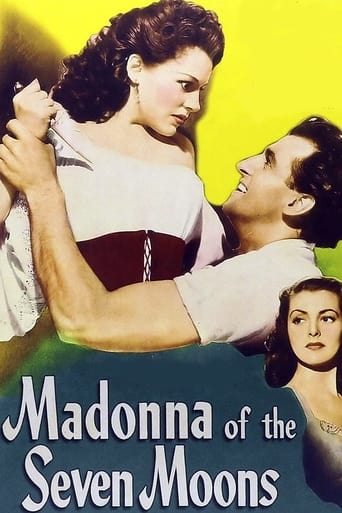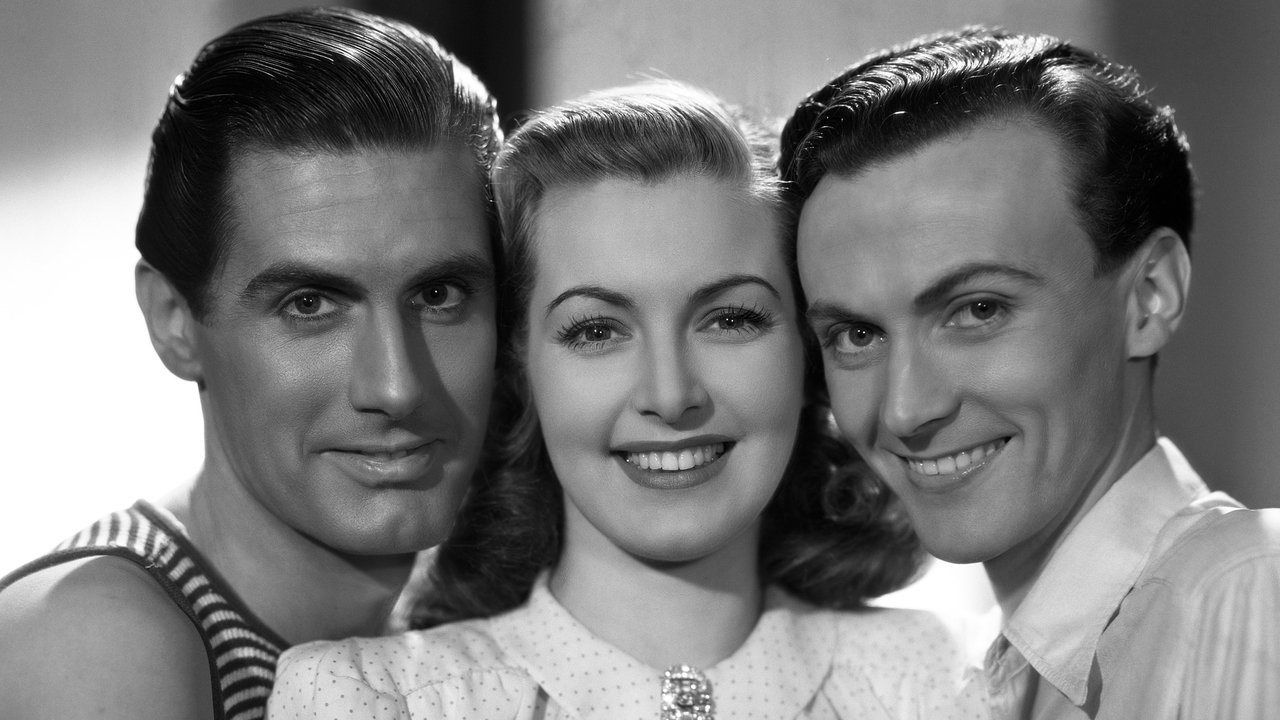mark.waltz
Part Merle Oberon and part Maria Montez, former convent girl Phyllis Calvet leads two lives: one a great lady, the other a fiery gypsy. Her husband (Peter Glenville) and daughter (Patricia Roc) find clues to try and find her after she disappears to return to the gypsy colony she had previously disappeared from a year before. This second personality has her involved with the equally fiery Stewart Granger who vows revenge when he comes to think she is stepping out on him.Handsome to look at but on occasion a pretentious bore, this isn't a total fiasco, but not one of Gainsborough's true classics. The film actually is more interesting when it shows Calvert's emotions erupting as she transforms into her alter. Dulcie Gray steals every scene she is in as a feisty housekeeper, exclaiming at one point that "If they expect something to eat, the only thing they'll get is a piece of my mind". It should be noted that the cause of Calvert's split personality is pretty daring for its day, showing that since the British censors were quite different than the American Hays code, they could get away with things the major studios in Hollywood couldn't. I must also make a mention that in addition to the excellent art direction, the film's sound quality (particularly with its music) is striking as well.
howardmorley
I only voted this film 3/10.I agreed with James Hitchcock's above user review which is accurate and to the point.I suppose (unlike today) if you had survived WW11 in 1945 you did not have much choice when going to the cinema for some needed light relief.This film is supposedly set in Florence/Italy yet it is a place where everyone speaks perfect English and as another user humorously put it in their comments, sound as if they are all at the Hunt Ball in Cheltenham!Not a word of "Parliamo Italiano" was heard throughout even by the "peasant locals".Most farcical casting was the mother - Phyllis Calvert who looked and was the same age as her grown daughter - Patricia Roc (a point made by other reviewers).Yet again we have a claustrophobically studio bound set with no relief of exterior shots and where the whole of Florence seems to be traversed in a 50 sq.yard of studio area and where characters suddenly appear in 5mins from one scene to another!A typical example was when Stewart Granger, in a comical fiesta outfit, appeared in the same bedroom as Phyllis Calvert (whose character had just died).Who let him into the villa? - I did not see how he gained entry! Normally I enjoy the Gainsborough melodramas as long as they have some credulity, e.g. "Love Story" (1944), "The Man in Grey" (1943) and of course "The Wicked Lady" (1945) but this film was one of Gainsborough's duds, war or no war.The screenwriter/producer in my opinion have a lot to answer for producing this travesty.
James Hitchcock
British films of the forties, such as the well-known "Brief Encounter", were often characterised by emotional reserve, but occasionally the British film industry could go to the opposite extreme and produce full-blown melodramas, marked by an excess of emotion rather than by a lack of it. BBC2, as part of a season of famous British films, has recently shown two examples from 1945, "Madonna of the Seven Moons" and "The Seventh Veil". (It is interesting that both titles feature the number seven, often thought to have some mystical significance)."Madonna of the Seven Moons" was made by Gainsborough Pictures, a company often associated with historical melodrama. The plot is, if anything, even more hysterically over-the-top than that of "The Seventh Veil". The action is set in Italy. Maddalena, a young girl, is attacked by a peasant while out walking in the countryside. (We presume that she is raped, but in the moral climate of the forties this could not be referred to explicitly). Maddalena marries a wealthy man, Giuseppe Labardi, but her ordeal has left her mentally disturbed and she develops a split personality. ("The Seventh Veil" also concerns a woman suffering from psychiatric illness). Whenever confronted with an emotional crisis she suddenly, and inexplicably, disappears from her home and reappears in a working-class district of Florence where she lives a double life as the gypsy girl Rosanna, the mistress of the criminal Nino Barucci. (The title is derived from the symbol of the seven moons carved above the door of Barucci's home). While she is living her life as Rosanna, she has no memory of her life as Maddalena, and vice versa, but eventually something will reverse the change in her personality and she will return to her life as part of the bourgeois Labardi family. Maddalena's family have no idea where she goes to when she vanishes, and much of the plot concerns the efforts of her daughter Angela to discover the truth about her mother. (Nino is equally concerned to find out where his mistress goes when she is not with him).The film's Italian setting was presumably intended to be more glamorous and exotic than a British one would have been, and Barucci and the other working-class characters in the "Rosanna" scenes do indeed seem to be living in a sort of prettified, picturesque ethnic poverty. The "Maddalena" scenes, however, do not seem exotic at all. Indeed, apart from the names of the characters there is nothing that might suggest that these scenes are set anywhere other than in Britain. The Labardis have a number of British friends, and the British characters and the Italian ones (all played by British actors) all speak with the same upper-class English accents. Although the film is set in the late 1930s, no mention at all is made of Mussolini, the Fascist party or the approaching war. The film was made very late in the war, after Italy had switched to the Allied side. Perhaps it was felt that to mention such matters might be tactless towards out new-found allies.The casting of Phyllis Calvert as Maddalena/Rosanna (a woman in her late thirties) and of Patricia Roc as Angela (in her late teens) is curious. Calvert and Roc were two of the most glamorous British actresses of the period, but were almost exactly the same age, both being twenty-nine when the film was made. It is therefore difficult to envisage them as mother and daughter. Stewart Granger, who plays Nino, was an actor accustomed to playing handsome, dangerous and fascinating rogues (Jeremy Fox in "Moonfleet" is another good example), but here he is unable to perform the service which James Mason performed for "The Seventh Veil", that of lifting the film above the level of the mundane.There are some good things about the film; Calvert, for example, copes well with the challenge of effectively playing two different characters in one film. Overall, however, this is a mediocre film marked by overblown melodrama and a plot which is excessively complex and at times (especially during the first half) confusing. 5/10
Jem Odewahn
Gainsborough Pictures is probably most famous for the wide variety of melodramatic romantic (often costume) dramas it produced in the heydays of the 1940's. MADONNA OF THE SEVEN MOONS (1945) is one of the strangest, kinkiest examples of Gainsborough melodrama, yet it is also, despite it's wild, unbelievable melodrama, quite a finely made film and a very entertaining one at that.The film concerns the highly implausible premise of a woman, Maddelena (Phyllis Calvert)Labardi, having completely split identities. For long periods she is the married, repressed English lady, complete with clipped vowels and high collars. Her daughter Angela comes home from boarding school, and it is soon revealed that something is not quite right with her mother. She has strange spells of behavior where she appears to be somewhere completely different, reacts badly to Angela's modern dress and spirit, and faints at the sight of Sandro Barucci (Peter Glenville), one of Angela's friends invited for a party. Soon Maddelena becomes Rosanna, a gypsy woman who cavorts in the Florentine underbelly with her dark, handsome, devilish lover Nino Barucci (Stewart Granger).Calvert's complex character apparently has no idea of her illness, or her "other self" when she is either Maddelena or Rosanna. The only things that trigger awareness are religious symbols, the "seven moons" and set of jewelery. Angela and her fiancé soon venture to Florence to uncover the truth, and it of course ends in tragedy as Calvert's two identities catch up with and threaten one another.The idea of Phyllis Calvert, refined English leading lady and all, as an amnesiac posing as a free-living Italian gypsy girl is not as ridiculous as you may think. Calvert plays her dual roles very well, quite convincing as both the repressed upper-middle class housewife and the long-haired gypsy, alternately puffing on cigarettes and sexily cavorting with her thief lover Granger.Granger, who was Gainsborough's second most famous male lead after the great James Mason, does not have to do much else here apart from smolder and play a bit of a rough with Calvert in low-necked, sweaty shirts and carnival costumes. Granger was undoubtedly nowhere near as talented as the brooding, saturnine Mason who he had starred with in the "definitive" Gainsborough costume melodrama THE MAN IN GREY (1943), yet he is a strong screen presence regardless. Lovely Patricia Roc, often the second lead to Calvert or Margaret Lockwood (see THE WICKED LADY), is quite capable as the daughter, though it is a tad hard to buy the "mother-daughter" Clabert and Roc, as they were only separated by a few years at most.The set design and the production values are top-rate for a British studio in time of war. Of course the plotting is outlandish, but it's just so damn entertaining that many viewers can overlook the implausibility of the situation. As with most of the Gainsorough melodramas, a woman is the protagonist here, and we are led to believe that becoming the gypsy Rosannna is Calvert's attempt at transgressing a staid upper-class British society. The psychological premise of the plot is rather flimsily handled and barely explored, yet we are left with an interesting portrayal of a woman who, apparently raped by a gypsy when young, has no control over the competing sides of her personality.Above all, MADONNA OF THE SEVEN MOONS is great because it's just typical Gainsborough...melodrama, steamy love scenes (the reunion scene between Granger and Calvert is quite hot!), betrayal, murder, lust...see it!



 AD
AD


